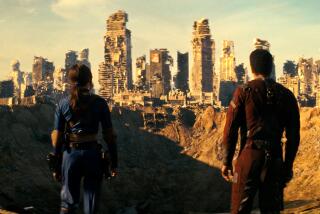An Archeology Spectacular : Unearthing the Set of DeMille’s 1923 ‘Ten Commandments’
- Share via
GUADALUPE, Calif. — An ancient Egyptian eye, unblinking in the sandy wind, stared up at Peter Brosnan. And Peter Brosnan, a bearded Angeleno with $10,000, a borrowed ground-penetrating radar system and a crazy dream, stared back.
“Take a look at this guy,” said Brosnan. “That’s the Pharaoh.”
And that’s why Brosnan, 38, a screenwriter, teacher and documentary filmmaker, started digging in the dunes near this Santa Barbara County city of 5,500 in 1983. This is where Cecil B. DeMille filmed the silent movie version of “The Ten Commandments” in 1923, and where DeMille buried and abandoned one of the largest sets in feature film history--the City of the Pharaoh, with walls that rose 110 feet and sprawled 750 feet in width, its entrance flanked by 21 sphinxes and four 35-foot Pharaoh statues.
Brosnan was at the site Monday to announce his most substantial progress so far in unearthing the city: a $10,000 grant from the Bank of America, most of it already committed to covering costs of equipment rental and consultation from experts.
Archeologist John Parker, who labored with Brosnan, geophysicist Lambert T. Dolphin and a handful of others, reported radar readings that indicate several large objects beneath the sand just where the old sphinxes should be. Parker said several other findings match with old charts and suggest that while many objects have been dismantled or damaged, most features remain largely where they were in 1923.
“We knew this was up here, but we figured it was rubble,” said Ed Edwards, a volunteer on the site and a member of the Santa Maria Valley Archeological Society.
“This is utterly unique, and it gives you a sense of time having passed--that movies are now a part of history,” Jarell Jackman, executive director of the Santa Barbara Trust for Historical Preservation. “Some archeologist may be uncovering Disneyland 500 years from now.”
“It would be an awfully interesting acquisition. And it would be nice to send somebody out there,” said Ellen Hughes, historian with the Smithsonian Institution’s National Museum of American History. Any decision, however, Hughes said, would require further study.
Bank of America officials were quick to note their company’s own history with the film and the site. DeMille, a former bank employee and personal friend of bank founder A.P. Giannini, finished making the $1.4-million production by persuading Giannini to make him a loan. (Shortly before his death, DeMille remade “The Ten Commandments,” released in 1956, with sound, a genuine Egyptian setting, and Charlton Heston in the role of Moses.)
“We’re hoping the Hollywood community will take this on as a family project,” said Duncan Knowles, vice president and director of organizational communications for Bank of America.
If Brosnan has his way, the team will make a detailed mapping and extensive excavation of the site, use that data to attract more donations, and eventually either pack the choicest artifacts off to an American museum or use them as centerpieces for an educational center at the dunes site. Hollywood Heritage Inc., a Los Angeles preservation group, is acting as the umbrella organization handling donations and inquiries. Last and not least, Brosnan hopes to complete his documentary video on DeMille and his sand-bound legacy.
But the imponderables remain nearly as imposing as the walled city once was. Until this week’s findings could be analyzed in detail, neither the scientists nor the bankers were willing to estimate the cost of a more ambitious excavation. The Nature Conservancy manages the property, and has the fate of the dunes and the local shore birds to consider. No museum has made any commitments to display anything. And while the film industry has been generous with data surrounding the old film, Brosnan acknowledged, it has been less so with financial support.
Brosnan’s own history with the site dates back to a late-night conversation in 1983 with Bruce Cardozo, a former New York University film school confederate who mentioned the remains of the old set. Brosnan traveled to the site, quickly unearthed a DeMille horse’s head, and was soon embarked on a campaign.
The campaign stalled, however, while the property’s owners made the complicated arrangements that gave control of the site to the Nature Conservancy. It was 1989, Brosnan said, before he again began investing substantial amounts of time on the project. The one certainty, he added, looking down at the detritus in the dunes, is that many such hours lie ahead.
“It’s a hobby,” said Brosnan, “that got out of control.”
More to Read
Sign up for Essential California
The most important California stories and recommendations in your inbox every morning.
You may occasionally receive promotional content from the Los Angeles Times.














